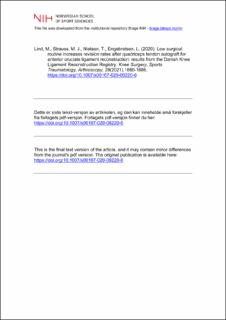| dc.contributor.author | Lind, Martin | |
| dc.contributor.author | Strauss, Marc Jacob | |
| dc.contributor.author | Nielsen, Torsten | |
| dc.contributor.author | Engebretsen, Lars | |
| dc.date.accessioned | 2021-09-01T12:45:05Z | |
| dc.date.available | 2021-09-01T12:45:05Z | |
| dc.date.created | 2020-10-22T13:33:52Z | |
| dc.date.issued | 2020 | |
| dc.identifier.citation | Knee Surgery, Sports Traumatology, Arthroscopy. 2020, 29(2021), 1880–1886. | en_US |
| dc.identifier.issn | 0942-2056 | |
| dc.identifier.uri | https://hdl.handle.net/11250/2772279 | |
| dc.description | Dette er siste tekst-versjon av artikkelen, og den kan inneholde små forskjeller fra forlagets pdf-versjon. Forlagets pdf-versjon finner du her: https://doi.org/10.1007/s00167-020-06220-0 / This is the final text version of the article, and it may contain minor differences from the journal's pdf version. The original publication is available here: https://doi.org/10.1007/s00167-020-06220-0 | en_US |
| dc.description.abstract | Purpose: Recent registry data have demonstrated a higher revision rate of quadriceps tendon (QT) graft compared with hamstring tendon (HT) and patellar tendon (PT) grafts. Clinic routines could be an important factor for revision outcomes. The purpose of this study is to use the Danish Knee Ligament Reconstruction Registry (DKRR) to compare revision rates in patients who have undergone ACLR with QT, HT and PT grafts related to individual clinic surgical routine. Methods: Data on primary ACLRs entered in the DKRR from 2012 through 2019 were analysed since QT graft usage started in 2012. Revision rates for QT, HT and PT grafts were compared according to clinic activity (0–100 and > 100 procedures). Revision rates for the three autograft cohorts are presented, as well as adjusted revision hazard rates. Instrumented knee stability and pivot-shift tests were performed at a one-year follow-up. Result: QT revision rate (6.4%) for low-activity clinics was higher than for high-activity clinics (2.9%) (p = 0.003). The adjusted revision hazard ratio for low-activity clinics was 2.3 (p = 0.01). QT autograft was associated with statistically significant, increased side-to-side laxity at follow-up (1.4 mm) compared with HT and PT autografts (1.0 mm) (p < 0.01), as well as an increased positive pivot-shift rate. Conclusion: QT autografts for ACLR were associated with higher revision rates in clinics with lower than 100 procedures performed from 2012 to 2019. QT graft usage is not associated with a high revision rate when routinely performed. Learning curve is an important factor when introducing QT ACLR. | en_US |
| dc.language.iso | eng | en_US |
| dc.subject | quadriceps tendon | en_US |
| dc.subject | hamstring tendon | en_US |
| dc.subject | patellar tendon | en_US |
| dc.subject | ACL reconstruction | en_US |
| dc.subject | clinical outcomes | en_US |
| dc.title | Low surgical routine increases revision rates after quadriceps tendon autograft for anterior cruciate ligament reconstruction: results from the Danish Knee Ligament Reconstruction Registry | en_US |
| dc.type | Peer reviewed | en_US |
| dc.type | Journal article | en_US |
| dc.description.version | acceptedVersion | en_US |
| dc.source.pagenumber | 7 | en_US |
| dc.source.journal | Knee Surgery, Sports Traumatology, Arthroscopy | en_US |
| dc.identifier.doi | 10.1007/s00167-020-06220-0 | |
| dc.identifier.cristin | 1841479 | |
| dc.description.localcode | Institutt for idrettsmedisinske fag / Department of Sports Medicine | en_US |
| cristin.ispublished | true | |
| cristin.fulltext | postprint | |
| cristin.qualitycode | 1 | |
